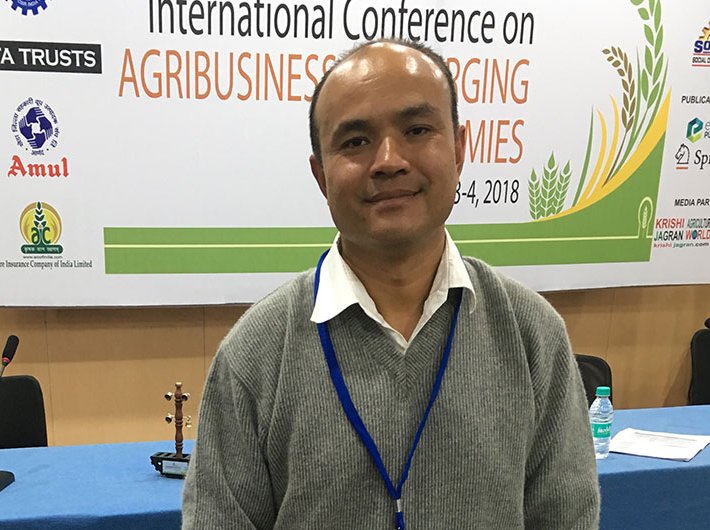When Bhupen Gurung from the Royal University of Bhutan told the audience at the TERI School of Advanced Studies, New Delhi, about dropping levels of poverty in Bhutan, many public policy academicians were left intrigued. Coming from the ‘Land of Happiness’ (Bhutan ranked 97 among 155 countries in the UN list of happy nations in 2017), Gurung attributed the success to interventions in agriculture and education. He is a lecturer and head of social science centre at Samtse College of Education. Earlier this week he was in New Delhi to deliver a lecture on food and nutrition security. Gurung spoke to Archana Mishra about social security programmes and challenges in implementing those programmes in a landlocked country.
Bhutan’s poverty rate has come down from 23.2 percent in 2007 to 8.2 percent in 2017. How did the country achieve this feat?
Bhutan is a small country. It is, therefore, easy to talk about the country quantitatively while simultaneously focusing on the qualitative aspects relating to living condition. The Constitution of Bhutan provides for adequate livelihood by protecting agricultural resources through the Food Act, the Forest and Nature Conservation Act (royalty-free domestic consumption of non-wood forest produce), bio-security policy, national health policy and economic development policy. It is possible through good governance, environment conservation, preserving tradition and culture and sustainable socio-economic development. All these developmental activities are screened through the Gross National Happiness (GNH) tool, which includes all the above four pillars.
The key area where the country has seriously worked upon is poverty alleviation. Today, the minimum per capita income is 2195.95 ngultrum (one ngultrum is 0.99 Indian rupees). Out of which expenditure on food is 1,473.40 ngultrum and 722.50 on non-food items. Today, people who are spending less than 1,473 ngultrum on food are in the poor category. They comprise only 1.5 percent of the population. The best part is policy makers are directly in touch with people working on ground. Bureaucrats have a very little role to play. Therefore, policies are able to address real issue.
In rural areas the government provides a power subsidy up to 100 units. People in rural areas need not pay for 100 units of electricity consumed. We have safe drinking water supply schemes in rural areas. We promote rural microfinance schemes for cottage and small-scale industries where loans are provided to rural entrepreneurs with minimum interest rate of 4 percent by Rural Enterprise Development Corporation Limited (REDCL) whereas the commercial banks charge 10-12 percent.
The country has also done fairly well in bringing down the malnourishment. Your comments?
In 2010 the stunting rate in Bhutan was 35.5 percent. It reduced to 21 percent in 2015. Likewise, the percentage of underweight children declined from 12.7 percent to 9 percent and wasting from 5.9 in 2010 to 4.3 percent in 2015. Less than two percent of the population has Vitamin A deficiency. This became possible due to a school feeding programme. Ninety-nine percent of the food security issue is dealt with through this programme. Village communities are linked to schools under this programme which allows them to sell their agriculture produce and vegetable to schools. In summers, that is, from April to October, farmers grow vegetables and sell it to schools as these are the months during which schools are in full operation. The policy is, we first buy the produce from local community. If the demand is not fulfilled then only we go for import. The linkage between farmers and community is established through local leaders and an agriculture extension officer in each district. So far the production has been on voluntary basis and the committee has reacted very well.
Second factor is construction of farm roads. Earlier, accessibility to families living in difficult mountainous terrain was difficult. Everything was community dependent. Not enough interventions could reach timely and properly. Road construction played a crucial role. Communities were handling social issues in isolation. After 2013, farm road construction picked up at a massive scale connecting all villages surviving in isolation. I remember reaching a village used to take two days because we had to walk long distances.
Tell us in detail about the school feeding programme.
In Bhutan, schools function in residential capacity and provide breakfast, lunch, snacks and dinner. The routine is not restricted to just one school but to all schools in each district. We have allocated 1,000 ngultrum for each student per month. We are therefore able to provide proper meals to children. Through this programme we are trying to assist farmers too. People don’t want to do cultivation because they don’t have markets. So, the government is encouraging them to scale up the production of food crops and allowing them to market their produce to schools. There are a few central schools in Bhutan which have created their own agricultural land and they don’t need any assistance from outside to run the school feeding programme. The country also runs a school agriculture programme and nutritional advocacy programme in which students are taught about agricultural practices in theory and through practical.
What are challenges on the agricultural front in making the country food secure?
Although the scenario in Bhutan looks quite stable, the country faces its own set of challenges. The trouble with the country is poor supply of cereals. Only 69 percent of the total demand is met through domestic production. The remaining 31 percent is met through import from India. Meanwhile, the country is exceptionally sufficient in maize and vegetables production. Especially in summers the vegetable production is almost 120 percent. The ample stock of potatoes, cabbage and cauliflower is exported to neighbouring Indian state of West Bengal.
Almost half of the country is protected by national parks and wildlife sanctuaries. Bhutan has almost 71 percent of its land under forest cover and is the only country in the world where it is enshrined in the constitution that it would maintain 60 percent of its forest cover in all times. However, the country can feed its population if the country and its people (farmers) use its resources productively. Factors such as urban migration, shortage of farm labour and access to market because of topography are some of the challenges. Shortage of water for irrigation purposes is also one of the major constraints in farming.
You mentioned that cereal production in the country is not sufficient. How does it affect the food eating pattern of the population?
Over the years we have turned into a rice-consuming nation. Food habits are changing drastically, mostly among people surviving on high-altitude crops. Until the 1960s millet, buckwheat and maize were largely consumed. But there is a shift in the food consumption pattern. Millet is a traditional crop. In terms of taste and behaviour, people no longer want to consume millet. The question is how we initiate a food practice that is in alignment with tradition. The standard preference currently is a switch to rice but it is difficult to cultivate. The production cost of rice is very high and not an agriculturally viable option. Therefore, the government is trying to revive rice cultivation by providing good quality seeds and irrigation facilities. The government is pumping a whole lot of budget for this purpose.
-----------------------

